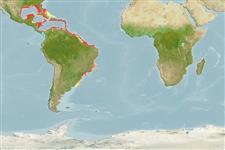>
Clupeiformes (Herrings) >
Dorosomatidae (Gizzard shads and sardinellas)
Etymology: Sardinella: Latin and Greek, sarda = sardine; name related to the island of Sardinia; diminutive (Ref. 45335).
More on author: Steindachner.
Environment: milieu / climate zone / depth range / distribution range
بوم شناسي
دريايي; لب شور; اقیانوس رو; تغييرات عمق 5 - 60 m (Ref. 114041). Subtropical; 31°N - 36°S, 98°W - 35°W
Western Atlantic: Gulf of Mexico, Caribbean, West Indies southward to Brazil and northern Uruguay (identifications are not always reliable).
Length at first maturity / Size / Weight / سن
Maturity: Lm 19.2 range ? - ? cm
Max length : 27.0 cm TL جنس نر / بدون خواص جنسي; (Ref. 103182); common length : 20.0 cm SL جنس نر / بدون خواص جنسي; (Ref. 188)
خارهاي باله پشتي (کل) : 0; شعاع نرم باله پشتي (کل) : 13 - 21; خارهاي باله مخرجي: 0; شعاع نرم باله مخرجي: 12 - 23. Diagnostic features as for Sardinella aurita from which it differs in having the anterior gill rakers on the lower limbs of the second and third gill arches distinctly curled downward (more or less flat in S. aurita) (Ref. 188). The pelvic fin ray count of i 8 distinguishes S. brasiliensis from all other species of Sardinella, also Harengula and Opisthonema (Ref. 188). Similar to S. aurita (Ref. 26938). Bluish black above. Peritoneum black (Ref. 37032). Separation of Sardinella brasiliensis (synonym of Sardinella janeiro) from Sardinella aurita on the basis of gill raker shape and a higher gill raker count is tentative.
Found in coastal waters, often forming compact schools. Maximum depth range based on spawners in Brazil (Ref. 114041). Probably similar to S. aurita, but if they are indeed distinct, then this species may account for the double spawning peaks of S. aurita. Constitutes a large fishery in Venezuela, but statistical reports are not separated from S. aurita. Marketed fresh and canned (Ref. 5217).
Life cycle and mating behavior
Maturities | تولید مثل | Spawnings | Egg(s) | Fecundities | توزاد ( لارو)
Whitehead, P.J.P., 1985. FAO Species Catalogue. Vol. 7. Clupeoid fishes of the world (suborder Clupeoidei). An annotated and illustrated catalogue of the herrings, sardines, pilchards, sprats, shads, anchovies and wolf-herrings. FAO Fish. Synop. 125(7/1):1-303. Rome: FAO. (Ref. 188)
وضعيت در فهرست قرمز IUCN (Ref. 130435)
خطر برای انسان ها
Harmless
استفاده انسانی
ماهي گيري – شيلات: با ارزش تجاري بالا; طعمه: usually
ابزارها
گزارش های ويژه
بارگيری XML
منابع اينترنتي
Estimates based on models
Preferred temperature (Ref.
123201): 22.7 - 28, mean 26 °C (based on 290 cells).
Phylogenetic diversity index (Ref.
82804): PD
50 = 0.5000 [Uniqueness, from 0.5 = low to 2.0 = high].
Bayesian length-weight: a=0.00813 (0.00670 - 0.00986), b=3.03 (3.00 - 3.06), in cm total length, based on LWR estimates for this species (Ref.
93245).
Trophic level (Ref.
69278): 3.1 ±0.30 se; based on food items.
جهندگی (Ref.
120179): زياد, كمينه زمان لازم براي دو برابر شدن جمعيت ، كمتر از 15 ماه (K=0.44-0.72; tm=1).
Prior r = 0.40, 95% CL = 0.26 - 0.60, Based on 1 data-limited stock assessment.
Fishing Vulnerability (Ref.
59153): Low vulnerability (23 of 100).
Climate Vulnerability (Ref.
125649): Low vulnerability (11 of 100).
Nutrients (Ref.
124155): Calcium = 141 [78, 222] mg/100g; Iron = 1.98 [1.21, 3.20] mg/100g; Protein = 21.3 [20.4, 22.2] %; Omega3 = 0.456 [0.234, 0.849] g/100g; Selenium = 41.7 [21.8, 80.6] μg/100g; VitaminA = 22.8 [7.3, 71.3] μg/100g; Zinc = 0.804 [0.591, 1.190] mg/100g (wet weight);
